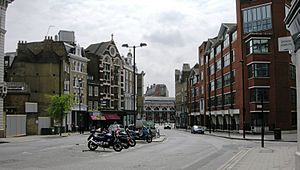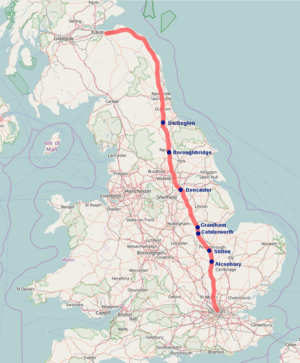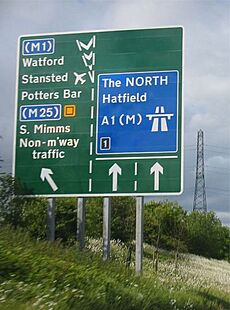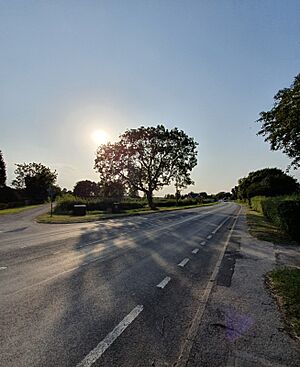Great North Road (Great Britain) facts for kids
The Great North Road was a super important road in England and Scotland. It was the main way to travel between these two countries for hundreds of years. From medieval times until the 1900s, it was like the main highway! Mail coaches used this road to carry letters and people between London, York, and Edinburgh. Today, the modern A1 follows much of the same path. Along the old road, there were many special places called coaching inns. These inns were like hotels where travelers could rest, eat, and change their horses. Many of these old inns are still around today, but you usually won't see them from the A1 because the new road goes around the towns where they are located.
The Journey Begins

The Great North Road traditionally started in Smithfield Market in London. The very first part of the road was called St John Street. A little way up this street, there was a building called Hicks Hall. This building was built in 1612 and was used as the starting point to measure distances along the Great North Road. Even after the building was torn down in 1782, people still used its old spot to measure how far places were on the road.
The Great North Road followed St John Street until it reached a famous spot called the Angel Inn. This inn was a very important stop for coaches and travelers.
In 1829, a new main post office was built in London. Because of this, coaches started using a slightly different route. This new route is now part of the modern A1 road. It began at the Post Office and went along Aldersgate Street and Goswell Road before joining the old Great North Road near the Angel Inn.
From Highgate, the original road is now called the A1000 road. It goes through Barnet to Hatfield. From Hatfield, the road mostly followed what is now the B197 road through Stevenage to Baldock. Then, it roughly followed the path of today's A1 through Biggleswade and Alconbury. These towns also had many traditional coaching inns.
Important Stops Along the Way
At Alconbury, the Great North Road joined an even older route called the Old North Road. This older road followed an ancient Roman road called Ermine Street. A special stone marker here shows the distances to London using both routes: 65 miles by the Old North Road and 68 miles by the Great North Road.
From Alconbury, the Great North Road followed the path of Ermine Street north. It went through Stilton and crossed the River Nene at Wansford. The road then passed through the center of Stamford, which had some very sharp turns! Famous inns along this part of the road included the George in Stamford and the Bell Inn in Stilton. The Bell Inn was where the famous Stilton cheese was first sold!
At Colsterworth, the Great North Road turned away from the Roman road. It continued through towns like Grantham, Newark, Retford, and Bawtry before reaching Doncaster. North of Doncaster, the Great North Road followed a short part of another Roman road called the Roman Ridge. Further north, it crossed another Roman road called Dere Street near Boroughbridge. From there, it continued through places like Dishforth, Topcliffe, Northallerton, Darlington, Durham, and Newcastle, all the way to Edinburgh.
The Golden Age of Coaches
In the early days of stage coaches, the city of York was the end of the Great North Road. But later, a more direct path to Edinburgh became popular. This new path went through Doncaster, Ferrybridge, Wetherby, Boroughbridge, Northallerton, and Darlington.
The very first stage coach from London to York started in 1658. This journey took four days! But things got much faster. In 1786, quicker mail coaches began using the route. This made all the other passenger coaches speed up too.
The time between 1815 and 1835 was known as the "Golden Age of Coaching." During this time, coaches could travel from London to York in just 20 hours. The trip from London all the way to Edinburgh took about 45 and a half hours. That was super fast for the time!
However, by the mid-1800s, new railways started to appear. Coaches just couldn't compete with the speed and efficiency of trains. The last coach from London to Newcastle left in 1842. The very last coach from Newcastle to Edinburgh stopped running in July 1847. The era of the Great North Road as a main coaching route had ended.




